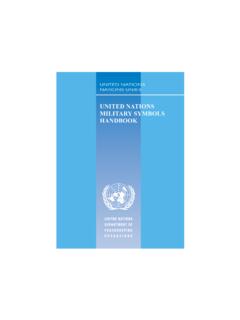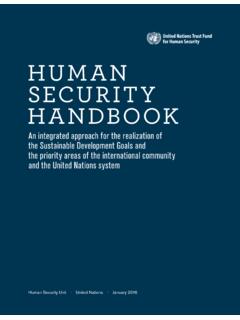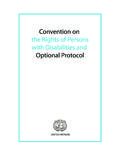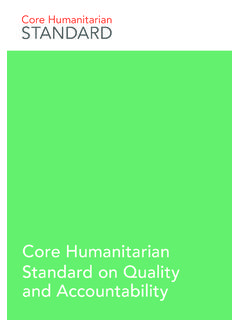Transcription of FRAMEWORK ON EFFECTIVE RURAL COMMUNICATION …
1 FRAMEWORK ONEFFECTIVE RURALCOMMUNICATIONFOR DEVELOPMENTFOOD AND AGRICULTURE ORGANIZATION OF THE united NATIONSROME 2006 FRAMEWORK ONEFFECTIVE RURALCOMMUNICATIONFOR DEVELOPMENTP ublished by theFood and Agriculture Organization of the united Nationsand theDeutsche Gesellschaft f r Technische Zusammenarbeit (GTZ) GmbHedited byRiccardo Del CastelloandPaul Mathias BraunThe designations employed and the presentation of material in this publication do not imply theexpression of any opinion whatsoever on the part of the Food and Agriculture Organization of theUnited Nations concerning the legal status of any country, territory, city or area or of itsauthorities, or concerning the delimitation of its frontiers or views expressed herein are those of the authors and do not necessarily represent those of theinstitutions with which they are rights reserved.
2 Reproduction and dissemination of material in this information product foreducational or other non-commercial purposes are authorized without any prior writtenpermission from the copyright holders provided the source is fully acknowledged. Reproductionof material in this information product for resale or other commercial purposes is prohibitedwithout written permission of the copyright holders. Applications for such permission should be addressed to:the Chief, Electronic Publishing Policy and Support Branch, Information Division, FAO, Viale delle Terme di Caracalla, 00153 Rome, Italy or by e-mail GTZ, Deutsche Gesellschaft fuer Technische Zusammenarbeit (GTZ) GmbH, PO Box 5180, 65726 Eschborn, Germany. Copyright 2006 FAO and GTZiiiiv181318273239485263 AcknowledgementsForewordIntroductionHow to use the FrameworkThe Six Success Factors forEffective RURAL CommunicationSuccess Factor 1: PolicySuccess Factor 2: CapacitiesSuccess Factor 3: Monitoring and EvaluationSuccess Factor 4: Farmers OrganizationsSuccess Factor 5: Participatory MethodsSuccess factor 6: Media StrategyAnnex1: Literature, Links, Tools and NetworksAnnex 2: FAO/GTZ Workshop ParticipantsCONTENTSCONTENTSiiiFRAMEWORK ONEFFECTIVE RURALCOMMUNICATIONFOR DEVELOPMENTFRAMEWORK ON EFFECTIVE RURAL COMMUNICATION FOR DEVELOPMENTivAcknowledgementshere are numerous people to thank for this book.
3 First our appreciationgoes to the 45 participants of the Laimburg workshop who contributedwith their ideas, opinions and most of all their expert field knowledge ofextension, agricultural research and COMMUNICATION for development. Withouttheir valuable inputs this publication would have not been possible. Theeditorial group as mandated by the workshop took on the responsibility forputting together all the results, discussions and recommendations from theworkshop into well defined and structured success factors. It consisted of:Mathias Braun, Michael Bosch, Clare O Farrell, Karin Nichterlein, Rainer Krelland Riccardo del Castello. Ian Houseman consolidated all of these contributionsinto a publication format. Special thanks also go to Pietro Bartoleschi and histeam for his professional advice and work on the design and layout.
4 Theorganization of the workshop and its follow-up work including this book, werecoordinated by Mathias Braun and Riccardo del Castello. TvFOREWORDhe FRAMEWORK on EFFECTIVE RURAL COMMUNICATION for Development isthe result of an inter-institutional expert consultation workshoporganized by the Food and Agriculture Organization of the UnitedNations (FAO) and the Deutsche Gesellschaft f r Technische Zusammenarbeit(GTZ) GmbH. The workshop was conducted jointly with the Research Centre forAgriculture and Forestry Laimburg and held at the Center s facilities in Ora(Bolzano, Italy) from 18 to 22 October 2004. The overall aim of the workshopwas to identify key issues in research-extension linkages and explorecommunication approaches and tools that can provide EFFECTIVE linkagemechanisms in line with the Millennium Development workshop was an example of knowledge management in action.
5 Itbrought together practitioners from 15 different countries and variousinstitutions in order to extract their explicit and implicit knowledge oncommunication and RURAL development. The forty-five participants discussedkey issues in research-extension linkages and identified, through a series ofwork space discussions and plenary sessions, six critical success factors thatare necessary to ensure EFFECTIVE design and implementation of ruraldevelopment projects. These success factors are: policy, capacity development,monitoring and evaluation, farmers and other RURAL organizations, participatorymethods and media strategy. The FRAMEWORK sets the scope and operational basis for the role ofcommunication in RURAL development. It is related to other approaches such as: the Neuch tel Initiative ( ), the RURAL Services FRAMEWORK ( ) and the International Food Policy Research Institute ( ).
6 Both FAO and GTZ have gained considerable experience in these fields andare mutually engaged in joint activities which put knowledge and informationat the heart of any RURAL development initiative. The Laimburg exercise andthis publication are just one obvious result of this collaboration other effectsare more restricted to the participants proper, like new linkages, cooperationand insights. ForewordTFRAMEWORK ON EFFECTIVE RURAL COMMUNICATION FOR DEVELOPMENTviThe readers who wish to have more information about the workshop candownload the proceedings from the FAO web site at: or from the GTZ/Agriservice website at: The FAO and GTZ have collaborated on the production of this handbook aspart of their on-going programmes supporting RURAL development andcommunication. This handbook is regarded as a live working document andcomments and suggestions on its content are welcome.
7 Please address theseto the editors. Paul Mathias BraunSupraregional Project on Knowledge Systems in RURAL DevelopmentGTZ - Eschborn, GermanyRiccardo del CastelloCommunication OfficerFood and Agriculture Organization of the united Nations Rome, ItalyRural COMMUNICATION and Developmentevelopment experiences of the last decades have shown that humanresources development is essential for food security and marketintegration. Achieving sustainable agricultural development is lessbased on material inputs ( , seeds and fertilizer) than on the peopleinvolved in their use. This focus on human resources calls for increasedknowledge and information sharing about agricultural production, as well ason appropriate COMMUNICATION methodologies, channels and tools. New agricultural technologies are generated by research institutes,universities, private companies, and by the farmers themselves.
8 Agriculturaladvisory services (including traditional extension, consultancy, businessdevelopment and agricultural information services) are expected todisseminate new technologies amongst their clients. The role of research andadvisory services is to give highly accurate, specific and unbiased technicaland management information and advice in direct response to the needs oftheir clients. Due to poor linkages between research and advisory services,the adoption of new agricultural technologies by farmers is often very slowand research is not focussing on the actual needs of farmers. In manycountries low agricultural production has been attributed, among otherfactors, to poor linkages between Research-Advisory Service-Farmers and toineffective technology delivery systems, including poor informationpackaging, inadequate COMMUNICATION systems and poor Agricultural Knowledge and Information Systems (AKIS), people andinstitutions are linked together to promote and enable mutual learning andgenerate, share and use agriculture-related technology, knowledge, skillsand information.
9 The system integrates farmers, agricultural educators,researchers, extensionists and the private sector (support and input services,traders) to harness knowledge and information from various sources forbetter farming and improved livelihoods. INTRODUCTIONI ntroduction1 DHowever, this integration among people and institutions, particularly inthe research-extension-farmer relationship, has not been successful in manyparts of the developing (and developed for that matter) world. Extensionservices are often under-equipped in terms of staff, transport andaccommodation as well as inadequately trained for EFFECTIVE in areas where small scale agriculture is predominant and a widearray of crops is grown, there is a need for extensionists with a broad level oftechnical skills and expertise.
10 There is also a basic difference in theinformation and extension needs between market-oriented, transitional andsubsistence based farming. In addition, recent experiences show thatdepending on the situation, the human components of the system go beyondthe researchers, educators, extensionists and farmers. Other key playerssuch as informal leaders, community workers, businessmen etc. contributesubstantially to the AKIS ON EFFECTIVE RURAL COMMUNICATION FOR DEVELOPMENT2 Source:Birner et al. 2006 IntroductionIn the traditional research context, agricultural scientists tend to overlooksituations at the farm level. Their research projects are often oriented atproducing publications rather than solving concrete on-farm on the other hand expect immediate answers to local problems,and are not concerned with experimental details or the goals and objectives ofthe linkage problems between major institutional actors are caused by alack of coordinated planning, poor COMMUNICATION between linkage partners,and absence of follow through with actual linkage resource planning orimplementation.



















